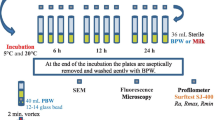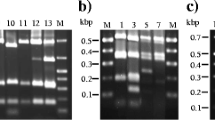Abstract
The sites of biofilm formation in an ice cream plant were investigated by sampling both the production line and the environment. Experiments were carried out twice within a 20-day period. First, stainless steel coupons were fixed to surfaces adjacent to food contact surfaces, the floor drains and the doormat. They were taken for the analysis of biofilm at three different production stages. Then, biofilm forming bacteria were␣enumerated and also presence of Listeria monocytogenes was monitored. Biofilm forming isolates were selected on the basis of colony morphology and Gram’s reaction; Gram negative cocci and rod, Gram positive cocci and spore forming isolates were identified. Most of the biofilm formations were seen on the conveyor belt of a packaging machine 8 h after the beginning of the production, 6.5 × 103 cfu cm−2. Most of the Gram negative bacteria identified belong to Enterobacteriaceae family such as Proteus, Enterobacter, Citrobacter, Shigella, Escherichia, Edwardsiella. The other Gram negative microflora included Aeromonas, Plesiomonas, Moraxella, Pseudomonas or Alcaligenes spp. were also isolated. Gram positive microflora of the ice cream plant included Staphyloccus, Bacillus, Listeria and lactic acid bacteria such as Streptococcus, Leuconostoc or Pediococcus spp. The results from this study highlighted the problems of spread of pathogens like Listeria and Shigella and spoilage bacteria. In the development of cleaning and disinfection procedures in ice cream plants, an awareness of these biofilm-forming bacteria is essential for the ice cream plants.
Similar content being viewed by others
References
Anonymous (1990). Compendium of Analytical Methods. Polyscience Publications Inc., Canada, Vol. 3
Arnold J.W., Silvers S. (2000). Comparison of poultry processing equipment surfaces for susceptibility to bacterial attachment and biofilm formation. Poult. Sci. 79:1215–1221
Autio T., Hielm S., Miettinen M., Sjöberg A., Aarnisalo K., Björkroth J., Mattila-Sandholm T., Korkeala H. (1999). Sources of Listeria monocytogenes contamination in a cold-smoked rainbow trout processing plant detected by pulsed-field gel electrophoresis typing. Appl. Environ. Microbiol. 65:150–155
Bagge-Ravn D., Ng Y., Hjelm M., Christiansen J.N., Johansen C., Gram L. (2003). The microbial ecology of processing equipment in different fish industries; analysis of the microflora during processing and following cleaning and disinfection. Int. J. Food Microb. 87:239–250
Blackman I.C., Frank J.F. (1996). Growth of Listeria monocytogenes as a biofilm on various food-processing surfaces. J. Food Protect. 59:827–831
Bower C.K., McGuire J., Daeschel M.A. (1996). The adhesion and detachment of bacteria and spores on food contact surfaces. Trends Food Sci. Tech. 7:152–157
Charlton B.R., Kinde H., Jensen L.H. (1990). Environmental survey for Listeria species in California milk processing plants. J. Food Protect. 53:198–201
Faille C., Fontaine F., Bénézech T. (2001). Potential occurrence of adhering living Bacillus spores in milk product processing lines. J. Appl. Microbiol. 90:892–900
Fuchs R.S., Sirvas S. (1991). Incidence of Listeria monocytogenes in an acidified fish product, ceviche. Lett. Appl. Microbiol. 12:88–90
Gibson H., Taylor J.H., Hall K.E., Holah J.T. (1999). Effectiveness of cleaning techniques used in the food industry in terms of the removal of bacterial biofilms. J. Appl. Microbiol. 87:41–48
Harrigan W.F., McCance M.E. (1976). Laboratory Methods in Food and Dairy Microbiology. Academic Press, London
Holt J.G., Kries N.R., Sneath P.H.A., Staley J.T., Williams S.T. (1994). Bergey’s Manual of Determinative Bacteriology. Williams and Wilkins, Baltimore Maryland USA, 9th ed
Hood S.K., Zottola E.A. (1997a). Growth media and surface conditioning influence the adherence of Pseudomonas fragi, Salmonella typhimurium, and Listeria monocytogenes cells to stainless steel. J. Food Protect. 60:1034–1037
Hood S.K., Zottola E.A. (1997b). Isolation and identification of adherent gram negative microorganisms from four meat-processing facilities. J. Food Protect. 60:1135–1138
ICMSF (1996). Microorganisms in Foods. Characteristics of Microbial Pathogens, Vol. 5. Blackie Academic and Professional, London.
Jeong D.K., Frank J.F. (1994). Growth of Listeria monocytogenes at 10 °C in biofilms with microorganisms isolated from meat and dairy processing environments. J. Food Protect. 57:576–586
Jessen B., Lammert L. (2003). Biofilm and disinfection in meat processing plants. Int. Biodeterior. Biodegradation 51:265–269
Joseph B., Otta S.K., Karunasagar I., Karunasagar I. (2001). Biofilm formation by Salmonella spp. on food contact surfaces and their sensitivity to sanitizers. Int. J. Food Microbiol. 64:367–372
Lunden J.M., Miettinen M.K., Autio T.J., Korkeala H.J. (2000). Persistent Listeria monocytogenes strains show enhanced adherence to food contact surface after short contact times. J. Food Protect. 63:1204–1207
Miettinen M.K., Björkroth K.J., Korkeala H.J. (1999). Characterization of Listeria monocytogenes from an ice cream plant by serotyping and pulsed-field gel electrophoresis. Int. J. Food Microbiol. 46:187–192
Mittelman M.W. (1998). Structure and functional characteristics of bacterial biofilms in fluid processing operations. J. Dairy Sci. 81:2760–2764
Ronner A.B., Wong A.C.L. (1993). Biofilm development and sanitizer inactivation of Listeria monocytogenes and Salmonella typhimurium on stainless steel and buna-N rubber. J. Food Protect. 56:750–758
Sharma M., Anand S.K. (2002a). Characterization of constitutive microflora of biofilms in dairy processing lines. Food Microbiol. 19:627–636
Sharma M., Anand S.K. (2002b). Biofilms evaluation as an essential component of HACCP for food/dairy processing industry-A case. Food Control 13:469–477
Somers E.B., Johnson M.E., Wong A.C.L. (2001). Biofilm formation and contamination of cheese by nonstarter lactic acid bacteria in the dairy environment. J. Dairy Sci. 84:1926–1936
Somers E.B., Schoeni J.L., Wong A.C.L. (1994). Effect of trisodium phosphate on biofilm and planktonic cells of Campylobacter jejuni, Escherichia coli O157:H7, Listeria monocytogenes and Salmonella typhimurium. Int. J. Food Microbiol. 22:269–276
Spurlock A.T., Zottola E.A. (1991). The survival of Listeria monocytogenes in aerosols. J. Food Protect. 54:910–912
Tompkin R.B. (2002). Control of Listeria monocytogenes in the food-processing environment. J. Food Protect. 65:709–725
Troller J.A. (1993). Sanitation in Food Processing. Academic Press, San Diego, 2nd ed., pp. 124–126
Warke R., Kamat A., Kamat M., Thomas P. (2000). Incidence of pathogenic psychrotropshs in ice creams sold in some retail outlets in Mumbai, India. Food Control 11:77–83
Wirtanen G., Husmark U., Mattila-Sandholm T. (1996). Microbial evaluation of the biotransfer potential from surfaces with Bacillus biofilms after rinsing and cleaning procedures in closed food-processing systems. J. Food Protect. 59:727–733
Wong A.C.L. (1998). Biofilms in food processing environments. J. Dairy Sci. 81:2765–2770
Author information
Authors and Affiliations
Corresponding author
Rights and permissions
About this article
Cite this article
Gunduz, G.T., Tuncel, G. Biofilm formation in an ice cream plant. Antonie Van Leeuwenhoek 89, 329–336 (2006). https://doi.org/10.1007/s10482-005-9035-9
Accepted:
Published:
Issue Date:
DOI: https://doi.org/10.1007/s10482-005-9035-9




